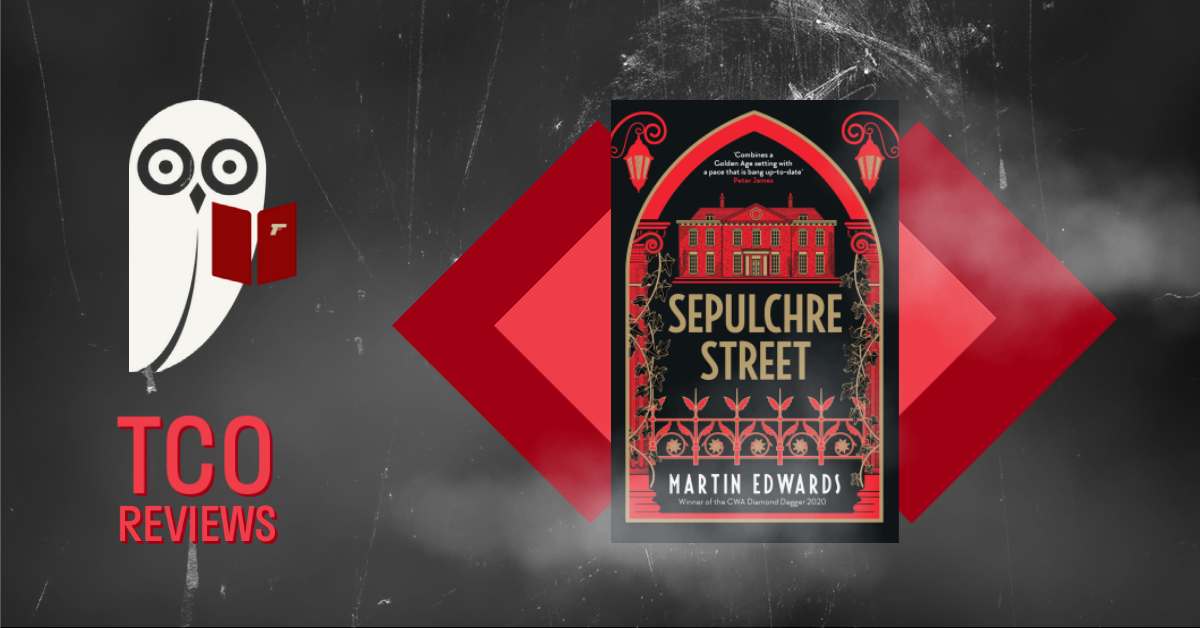I’ve got the making of a series on the brain, and it’s a perfect week to take on a new entry in the Rachel Savernake series by Martin Edwards. Sepulchre Street is Edwards’ fourth novel, and the fourth to feature his mysterious amateur sleuth, Rachel Savernake. Edwards is, of course, the premier expert on Golden Age / traditional mysteries, and I’d be excited to read this advance copy on his name alone. (Many thanks to Aria & Aries and NetGalley for the gift copy!) But I’ve also been a huge fan of his sleuth Rachel Savernake since I first picked up Gallows Court. The series is clever, compelling, and a dark contrast to some of my cozier “comfort” reads.
In this latest outing, Rachel and her crew pursue the alleged murderer of a dazzling contemporary artist. When Damaris Gethrin approaches Rachel to “solve her murder” – and then proceeds to execute on the same at her art exhibit – Rachel, Jacob, and the Truemans need to learn more. As they investigate further, they uncover and wrestle with layer on layer of conspiracy. It’s an intriguing premise, and Edwards is known for delivering on his puzzles. But can he keep it up in Sepulchre Street?
Rachel goes on an adventure
Martin Edwards is the ultimate scholar on Golden Age crime fiction, and it’s clear he loves the intellectual challenge of a good fair play mystery. He has brought that appreciation and wit to all of the prior entries in the Rachel Savernake series. He continues with the rigor in Sepulchre Street, going so far as to include a clue-finder at the end to “prove” the solution. If you, like me, enjoy feeling intellectually challenged by a mystery, then you will appreciate this approach. It’s nice to know that all elements of the ultimate solution are deducible with information fairly provided.
That said, Edwards has chosen to go a little closer to the modern adventure route than in prior entries. Rachel, Jacob, and the Truemans stumble into a broad conspiracy, and their actions incite behavior that actually uncovers information. Not only that – the criminals are also prodded on by external factors, revealing additional clues. There’s a larger element here of luck and/or conspiracy than in prior works – Rachel and the team have to be more reactive.
There’s nothing inherently wrong with this, and it can be fun to see what happens when an intelligent and resourceful character is put in a tough spot. But when I think of the Great Detectives, I always imagine a sense of control – that they generally have an understanding of possibilities and probabilities that allows each new incident to give them information. It’s the difference between the detectives leading the charge and simply deducing the outcomes. There’s nothing inherently wrong with either approach – but I’m surprised to see this more reactive mode from Edwards’ characters.
What makes a detective Great?
My first recommendation, should you choose to read this novel, is to quickly refresh yourself on the cast of the series. Edwards routinely references the team’s past adventures, and spends little time reintroducing the characters and their stories. Unfortunately, I did not have the opportunity to avail myself of this advice, and it took me a minute to refresh on each story and history before I could truly get into the swing of the novel.
Edwards continues to write Rachel with a vaguely mysterious past. While it was intriguing for a few novels, it’s wearing thin in book 4. Rachel continues to have infinite wealth and intelligence. She can do no wrong when it comes to detecting – she’s an effortless team leader and a great ally. But without enough of the personal touch, Rachel comes off as an in-story deus ex machina: there’s no doubt she and her team will survive unscathed.
Of course, a mysterious crime-solver can still work when the surrounding stories and characters are sufficiently engaging. And while the story in Sepulchre Street is full of dramatic events, the characters themselves are a little thin. The victim dies in a truly shocking way – but we learn very little about her as a person. In my reading notes, I’ve noted one character gives off “Irene Adler in Sherlock” vibes – that is, shallow with the ongoing promise of depth.
My instinct is that Savernake could be great, if Edwards could commit to either approach. If Rachel’s past stays vague, then the surrounding mysteries need to make up for it. Otherwise, it’ll be important to dive deeper into her story (and her crew’s). For the moment, Sepulchre Street fails to hit either mark.
Reader’s notes & rating (⭐⭐⭐✨)
The above criticisms are in the context of a well-written traditional mystery / adventure novel. I gulped Sepulchre Street down in a single sitting and enjoyed the more dark, atmospheric vibe of the writing. This is definitely a good read, just a niche one – and one that feels like it could have been even better. I’d recommend this to anyone who’s already a Martin Edwards fan – but if you’re just looking for a great traditional mystery and not already familiar with the series, I’d suggest starting with Gallows Court first. Because it’s so reliant on series attachment – 3.5 stars.
Read this if…
- You love Rachel Savernake (and have recently read the other books in the series)
- You appreciate the intellectual puzzle of a good fair-play / closed-circle mystery
- You’re looking for something a little more on the dark side of mystery
Skip this if…
- This is your first Rachel Savernake book
- You need to empathize with either protagonist or victim in your mysteries
- You’re looking for something cozy (like I often cover here)
Sepulchre Street by Martin Edwards will be released on August 27, 2024.
